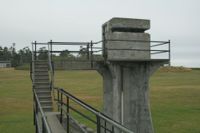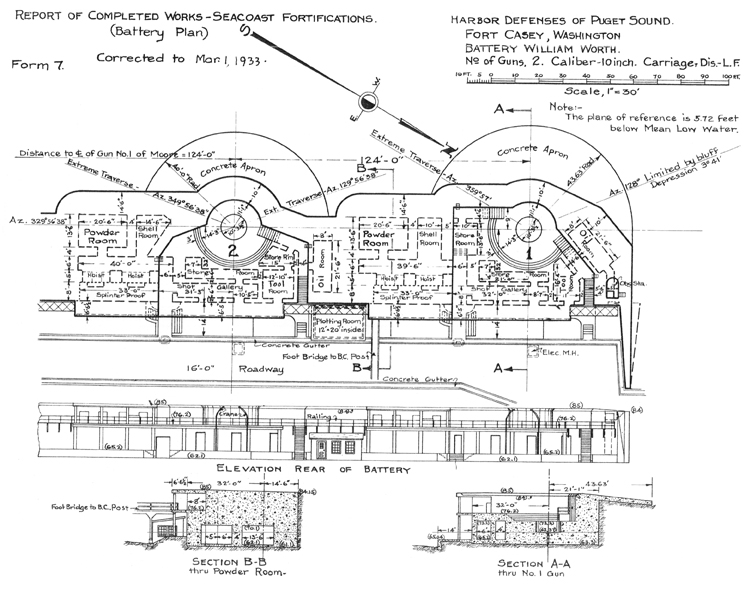Battery Worth (1): Difference between revisions
John Stanton (talk | contribs) m Text replace - "transferred to the Coastal Artillery" to "transferred to the Coast Artillery" |
John Stanton (talk | contribs) m Text replace - "<seo metadescription="Historic US and Canadian fortifications" /> " to "<seo metadescription="Historic US and Canadian fortifications" /> {| style="margin: 1em auto 1em auto" width="800px" |- | " |
||
| Line 1: | Line 1: | ||
{{SocialNetworks}} | {{SocialNetworks}} | ||
{{PageHeader}} | |||
'''{{PAGENAME}}''' (1902-1942) - Battery William Worth is a concrete [[:Category:Endicott Period Batteries|Endicott Period Coastal Battery]] located on [[Fort Casey (1)]],Whidbey Island, Island County, Washington. Named in G.O. 20, 25 Jan 1906, after BG [[William S. Worth]], who served with distinction during the [[U.S. Civil War]] and the [[Spanish-American War]], and who died 16 Oct 1904. The Battery was begun in 1897 and completed in 1898 and transferred to the Coast Artillery 16 Jun 1902 at a cost of $51,947. The battery was inactivated in 1942 during [[World War II]]. | '''{{PAGENAME}}''' (1902-1942) - Battery William Worth is a concrete [[:Category:Endicott Period Batteries|Endicott Period Coastal Battery]] located on [[Fort Casey (1)]],Whidbey Island, Island County, Washington. Named in G.O. 20, 25 Jan 1906, after BG [[William S. Worth]], who served with distinction during the [[U.S. Civil War]] and the [[Spanish-American War]], and who died 16 Oct 1904. The Battery was begun in 1897 and completed in 1898 and transferred to the Coast Artillery 16 Jun 1902 at a cost of $51,947. The battery was inactivated in 1942 during [[World War II]]. | ||
<!-- | <!-- | ||
Revision as of 19:32, 22 February 2015
|
Battery Worth (1) (1902-1942) - Battery William Worth is a concrete Endicott Period Coastal Battery located on Fort Casey (1),Whidbey Island, Island County, Washington. Named in G.O. 20, 25 Jan 1906, after BG William S. Worth, who served with distinction during the U.S. Civil War and the Spanish-American War, and who died 16 Oct 1904. The Battery was begun in 1897 and completed in 1898 and transferred to the Coast Artillery 16 Jun 1902 at a cost of $51,947. The battery was inactivated in 1942 during World War II.
Battery Worth (1) HistoryPart of the Harbor Defense of Puget Sound. Battery Worth was designed to protect both the Straight of Juan De Fuca and the Admiralty Inlet to Puget Sound. The 10" guns could fire a 571 pound projectile over 8 miles.  Originally built with two, 10" M1895 rifles mounted on M1896 disappearing L.F. carriages. This was a two story battery with guns on the upper level and separate magazines and support rooms below. Shell hoists were provided to move the projectiles from the magazine level up to the loading platform. Electric power could be furnished from commercial power, the central power plant or the power plant in the #3 emplacement of Battery Moore. In 1915 a BC post was built on a free standing concrete tower at the rear of the battery and a separate plotting room was built at the rear of the center of the battery. Both were accepted for service 31 Mar 1915.

World War IThe U.S. entry into World War I resulted in a widespread removal of large caliber coastal defense gun tubes for service in Europe. Many of the gun and mortar tubes removed were sent to arsenals for modification and mounting on mobile carriages, both wheeled and railroad. Most of the removed gun tubes never made it to Europe and were either remounted or remained at the arsenals until needed elsewhere. The two 10" guns at Battery Worth were apparently slated for service abroad but were ordered to be remounted and retained as the war drew to a close. World War IIThe original guns and carriages were declared obsolete and ordered scrapped 23 Oct 1942 during the first large scale, quota driven, scrap drive of World War II. Current StatusBattery Worth has two 10" guns with disappearing carriages currently on display that were obtained in 1967(1963) from Battery Warwick, Fort Wint, Subic Bay, Philippines. The #1 gun is displayed in the raised position while gun #2 is shown in the retracted position. Both breech blocks are missing because they were thrown into the Pacific Ocean to prevent enemy use when Fort Wint was abandoned at the beginning of World War II.
Sources: Links: Visited: 14 Apr 2010, 18 Jul 2008 Battery Worth (1) Picture Gallery
|
|||||||||||||||||||||||||||||||||||||||||||||||||



















